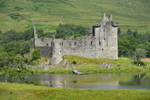History
The Clan MacDougall, the Lords of Lorn, built Castle Stalker around 1320. The MacDougalls lost their title after King Robert the Bruce defeated them at the Battle of Brander Pass but regained the title in 1328. In 1388 the Lordship of Lorn passed to the Stewarts, including their lands and Castle Stalker. Stalker in Gaelic is Stalcaire, which means Hunter or Falconer.

The current castle was likely built in the 1440s by the 3rd Lord of Lorn, Sir John Stewart, who had a son, Dugald, out of wedlock in 1446. In 1463 John married his son’s mother at Dunstaffnage Castle and was murdered outside the castle by Alan MacCoul. His son Dugald became the 1st Chief of Appin. The Stewarts would have their revenge on MacCoul at the Battle of Stalic in 1468, opposite the castle, when the Stewarts defeated the MacDougalls and Alan MacCoul, who Dugald himself killed.
Dugald was succeeded as Chief of Appin by his son Duncan in 1497 after being killed during a raid against Macdonald of Keppoch in reprisal for a cattle reiving. King James IV of Scotland was a cousin of the Stewarts of Appin and visited Castle Stalker frequently during hunting trips to the Highlands. Additions to the castle were made around this time, including the top floor and roof. Duncan Stewart was murdered in 1512 by the McLeans at Duart Castle and was succeeded by his younger brother Alan Stewart. In 1513 the Stewarts of Appin supported King James IV at the Battle of Flodden. Though King James was killed and the English routed the Scottish forces at Flodden, the Stewart Chief, and his five sons survived the battle.
Around 1620 the 7th Stewart Chief, Duncan, lost Castle Stalker to the Campbells of Airds due to a drunken wager in exchange for an eight-oared wherry. The Stewarts would regain the castle in 1689 when they supported King James VII against King William, but after being defeated at the Battle of Dunkeld, the castle was again fortified to the Campbells.
During the 1745 Jacobite Rising, Castle Stalker was garrisoned with about 59 Government troops under the Campbells. The Stewarts of Appin, supporting Charles Edward Stuart, Bonnie Prince Charlie, besieged the castle with 300 soldiers, but the castle held out against the siege. Castle Stalker was used during the rising as ships frequently stopped with troops and supplies as they sailed between Inveraray and Fort William. After the Loss at Culloden in 1746, Castle Stalker was used by Government forces as a center where Clansmen had to surrender their weapons.
In 1775 the last Campbell was born in the castle and continued to use it as a home until 1800 when they built a house on the mainland. By 1840, the roof had fallen in or been removed to avoid the roof tax, and the castle was abandoned.
The Stewarts purchased Castle Stalker from the Campbells in 1908 and conducted preservation work to keep the castle from further ruin. In 1947 Duncan Stewart was murdered, passing the castle to his widow. Then in 1965, Lieutenant Colonel D. R. Stewart Allward purchased the castle and spent the next ten years rebuilding and restoring it to its current state, once again a home.
Castle Highlights
Castle Stalker is a four-story tower house castle located on a tidal islet on Loch Laich, an inlet off of Loch Linnhe. The castle is privately owned but sometimes opens for visitors in summer. It is only accessible by boat when the tours are available. You must book online ahead of time, as tours are limited to 12 people a day. The Great Hall is the best feature inside the castle, containing large fireplaces, suits of armor, and medieval weaponry, including swords, spears, and targes.
The castle is very picturesque on its island and is worth the drive just viewing from across the Loch if you are in the area. It may look familiar to many as it appears in Monty Python, the Holy Grail (Castle of Arrrgh!), and Highlander Endgame. Kilchurn Castle and Dunstaffnage Castle are close enough to visit on the same day.



